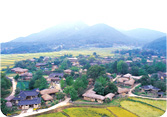World Heritage
Tentative List
- Kangjingun Kiln Sites (1994)
- Mt.Soraksan Nature Reserve (1994)
- Sites of fossilized dinosaurs throughout the Southern seacoast (2002)
- Salterns (2010)
- Southwestern Coast Tidal Flats (2010)
- Daegokcheon Stream Petroglyphs (2010)
- Ancient Mountain Fortresses in Central Korea (2010)
- Oeam Village (2011)
- Naganeupseong, Town Fortress and Village (2011)
- Upo Wetland (2011)
- Seoul City Wall (2012)
- Stone Buddhas and Pagodas at Hwasun Unjusa Temple(2017)
- Gaya Tumuli (2019)
 Oeam Village, a typical rural town of Korea, is a clan village, home to the Yi family hailing from Yean. Oral traditions have it that it was about 500 years
ago when people first inhabited the village site. But according to the records, the village was settled when the Yi clan moved to the site. The first person who settled in the village was Yi Sa-jong, and since his settlement,
the village prospered, emerging as a major clan village for the Yean Yi family in late Joseon (1392-1910).
Oeam Village, a typical rural town of Korea, is a clan village, home to the Yi family hailing from Yean. Oral traditions have it that it was about 500 years
ago when people first inhabited the village site. But according to the records, the village was settled when the Yi clan moved to the site. The first person who settled in the village was Yi Sa-jong, and since his settlement,
the village prospered, emerging as a major clan village for the Yean Yi family in late Joseon (1392-1910).
At the back of the village, Mt. Seolhwasan rises in the northeast and the mountain ranges encircle the village from behind. Also, the village faces Mt. Meonjeoksan in front and Mt. Bongsusan to its southwest. To the west, the village is bordered by a broad field, and a stream “Geundaegolnae” flows in between. It is the typical geographical features of a traditional rural village of Korea, having a broad field near the village.
The village was formed on the low hill of Mt. Seolhwasan. Houses are uniquely distributed along the main road, which is divided into many byroads leading inwards. The village seems to have been created sporadically corresponding to natural topographic conditions, but there is an underlaying principle in it: the village was settled along the straight line that connects Mt. Seolhwasan, the guardian mountain in the northeast, and Mt. Bongsusan in the southwest. The village is an oval shape settling in the low hill on the ranges of Mt. Seolhwasan stretching toward the southwest. The ground of the village is progressively higher toward the east and to fit this geographical condition, most houses were built facing southwest, with a few houses facing south.
The spatial composition of the village and houses display how Confucianism, the dominant ideology of Joseon, was settled in the society. Most villages that had emerged naturally went through an overall change at the beginning of the Joseon era, transforming itself befitting the novel ideology. The whole process can be witnessed in the village.
Most houses in the central part of Korea consist of two L-shaped buildings. The buildings are facing each other, creating a rectangular inner courtyard at the center. The characteristic features are well exhibited in the houses of Oeam Village.
What makes this village distinctive is an artificial waterway. The village draws water from the upper valley in the village, creating an eco-friendly environment and ecological landscape. The water has been used for daily life and firefighting, and mountain streams and ponds made using the water elaborate the gardens of houses. The character “hwa (華)” in the name of Mt. Seolhwasan, is a homonym for the character meaning “fire (火),” and the waterway was a symbolic means of balancing out the influence, making it a distinctive feature of the village not found in other places in Korea.
There are many houses showing the typical garden style of late Joseon. The gardens of Champandaek House, Geonjae Historic House, Gyosu House and Gamchal House are regarded highly important and unique, as they demonstrate special techniques and characteristic features of garden construction of the era. Ponds, waterfalls and streams were made using the artificial waterways, and valleys and artificial mountains were constructed with stones and ornamental plants. The gardens are very particular to this village.
Currently, there are 69 households residing in the town, and 38 of them are engaged in farming. The resident population is 192 people in total. More than half of the buildings are thatch-roofed. And every year, residents thatch their roof with new straw, and the technique has been handed down by tradition in the village, a work of valuable intangible cultural heritage. All the houses in the village are walled with stones from field, in that stones in various sizes were easily found in the town. Villagers built walls in the field too by using removed stones from the field. Again, this construction is very distinctive and is another special feature of Oeam Village. Champandaek House and Geonjae Historic House are State-designated Important Folklore Cultural Heritage, and in January 2000, the entire village was designated as Folk Village by the government. Additionally, valuable implements for daily life and intangible cultural heritage are transmitted in the village. Various rituals and offerings for ancestors and folklore events have continued, and traditional foods such as lotus-leaf liquor, food for ancestral rites and rice pancake (buggumi) were recognized unique to the village.



 >
>